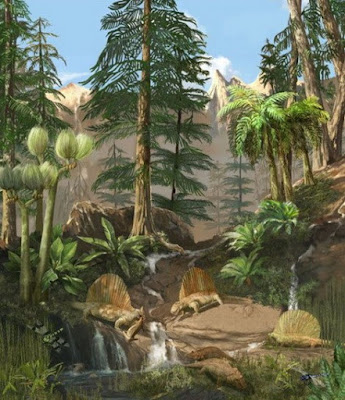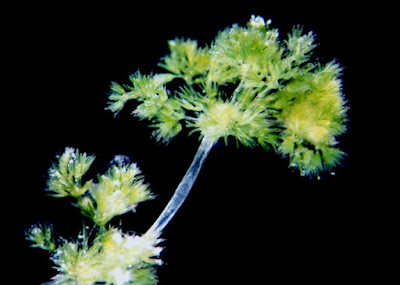Flower power. Angiosperm dominance.
The end of the Mesozoic era 140 million years ago not only
led to the mass extinction of dinosaurs, the once dominant gymnosperms which
covered the earths landscape would also diminish. Perhaps the most important
evolutionary event within the kingdom Plantae at the time, was the evolution of
seeded flowering plants, angiosperms (Rost 1998).
Angiosperms are all grouped within the phylum, Anthophyta.
Angiosperms, meaning “seed within a vessel”, make up 90% of all plants we see
today, between 300-450 000 species, making them by far the largest phylum of
photosynthetic organisms (Evert and Eichhorn 2013).
Much like gymnosperms, angiosperms also produce seeds,
however, many characteristics of their life cycles differ greatly. The
ovaries of angiosperms are enclosed within the carpel and ovules have two
layers of protective integument, whereas gymnosperms have a single integument (Rost 1998).
 |
| Comparison of gymnosperm and angiosperm integument layers |
Angiosperms produce flowers, reproductive structures which
group together pollen and ovule producing organs, the stamen and carpel, along with sepals, petals and penduncle (Wllis and
McElwain 2014). The stamen comprises of a stalk like filament and a pollen
producing anther, which produce the male gametophyte. The carpel produces
female gametophytes and is comprised of a stigma at the top of the carpel, a
style, and an ovary containing one or multiple ovules (Reece and Campbell 2012).
 |
| Cross section of a flower and associated reproductive structures |
Another distinctive characteristic of angiosperms is the
process of double fertilization. Two sperm are released from the pollen onto
the stigma and into the style which travel to the ovary. One sperm fertilizes
the ovule to form a zygote, whilst the other sperm combines with two polar nuclei
to produce primary endosperm, a food supply for the seed when formed (Willis
and McElwain 2014). Once fertilized, the ovule becomes a seed, and the ovary
transforms into a fruit, which in turn protects the gametophyte generation and
increases survival and radiation (Rost 1998).
 |
| Angiosperm lifecycle |
Angiosperms are divided in two groups based on the number of
seed leaves within the embryo, also known as cotyledons (Reece and Campbell
2012). Liliopsida are monocots, such as water lilies, and Magnoliopsida, such as roses are dicots (Reece and Campbell 2012). Monocots usually have parallel leaf
venation, dicots have a netlike venation. Vascular tissue within the stems of
monocots is scattered, whilst dicots are arranged in a ring. The root system of
monocots is fibrous and close to the substrate surface, dicots on the other
hand, have a main tap root. Pollen grains of monocots have a single opening,
dicot pollen has three. And finally, petals of monocots are arranged in multiples
of three, dicots are set in multiples of four or five (Reece and Campbell 2012).
 |
| Differences between monocots and dicot angiosperms. |
The combination of these amazing evolutionary innovations allow the continued
radiation and dominance of angiosperms within the plant kingdom.
Please double click to watch the video clip on you tube.
References
Evert, R.F., Raven, P.H. & Eichhorn, S.E. 2013, Biology of plants, Eighth edn, W.H.
Freeman and Company Publishers, New York.
Reece, J.B. & Campbell, N.A. 2012, Campbell biology, 9th (Australian version) edn, Pearson Australia,
Frenchs Forest, N.S.W.
Rost, T.L. 1998, Plant
biology, Wadsworth, Belmont, Calif.
Willis, K.J. & McElwain, J.C. 2014, The evolution of plants, Second edn, Oxford University Press,
Oxford.
Wikimedia 28 June 2008, Ovule
gymnosperm and angiosperm, image, viewed May 2018, < https://commons.wikimedia.org/wiki/File:Ovule-Gymno-Angio-en.svg>.
Peda.net 2018, Cross section of a flower, image, viewed
May 2018, < https://peda.net/kenya/css/subjects/biology/form-three/ripaa>.
Life of plant Blog spot 2018, Angiosperm lifecycle, image, viewed May 2018, < http://lifeofplant.blogspot.com.au/2011/12/angiosperm-life-cycle.html>.
Hoganix.com Benjamin Cummings 2018, Monocot and dicot differences, image, viewed April 2018, < https://www.holganix.com/blog/bid/59573/The-Science-Behind-Holganix-Monocots-vs-Dicots-What-You-Need-To-Know>.
Prof.G.V Bakore Foundation Sept 25 2013, Fertilization in
flowering plants. [online video]



While these evolutionary innovations are amazing in themselves, what really contributed to the evolutionary success of the angiosperms?
ReplyDelete